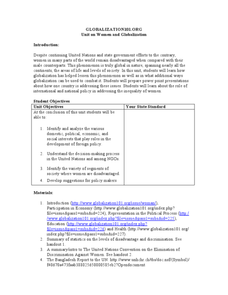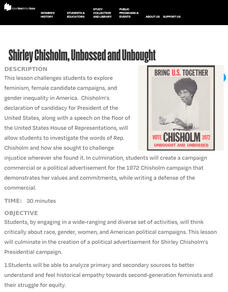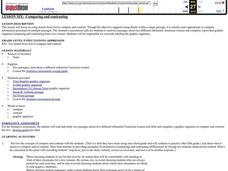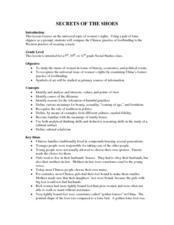Curated OER
First Black US Congresswoman Dies
In this English activity, students discuss Shirley Chisholm. Students debate and discuss American politics, focusing on Shirley Chisholm. Students discuss the differences compared to their own country of origin.
Curated OER
Comparing and Contrasting
Students listen to the story "Bloomers" and discuss the differences between men and women in the past. They chart their guesses about women's rights in history.
Curated OER
Dress Reform in the 19th Century
Students read and discuss the writings of Elizabeth Cady Stanton, Timothy Shay Arthur and others to explore mid to late 19th century dress reform. They use their findings to write a letter to an editor from a 19th century viewpoint.
Curated OER
Unit on Women and Globalization
Students create a PowerPoint presentation showing the role of women in globalization. They examine the decision-making process in the United Nations and develop suggestions for policy makers when it comes to woman's rights.
Curated OER
Suffragettes Activities
In this suffragettes worksheet, students match the words about suffrage with their meanings. Students list 8 methods the suffragettes used and one peaceful method they could have used.
Curated OER
Janet Guthrie
Learners explore the life of race car driver and physicist Janet Guthrie. In this social studies activity, learners investigate how Janet Guthrie followed her dream of becoming a race car driver. Students complete 7 activities that...
Curated OER
Speak Out!
Pupils are introduced to Yvonne Ranier's "Trio A" dance and investigate how to express concern over social issues through choreography. They research important issues from the 1960's, choreograph and perform original dances.
Illinois State Curriculum Center
Gender Roles and Careers
Should men be willing to work for women? Can women think as logically as men? Here is an interesting activity in which learners complete a survey regarding gender roles and then consider whether their scores reflect traditional or...
Curated OER
Ordinary People, Ordinary Places: The Civil Rights Movement
Students analyze Martin Luther King's message of nonviolent protest discover how individuals adapted his message to their own communities and situations.
Curated OER
Who Is Sarah Mae Fleming?
Fifth graders learn about two influential women. In this historical figures lesson, 5th graders work in groups to read articles about Rosa Parks and Sarah Fleming and share their findings with the class. Students use a Venn Diagram to...
National Woman's History Museum
Shirley Chisholm, Unbossed and Unbought
An engaging resource introduces young historians to Shirley Chisholm, the woman, the Black congresswoman, the activist, and the candidate for President in 1972. Class members study primary sources, watch a video of her announcing her run...
National Woman's History Museum
Dolores Huerta and the Delano Grape Strike
Few have heard of Dolores Huerta and her part in organizing the California farm workers, establishing the United Farm Workers union and orchestrating the Delano Grape strike. High schoolers consider why this powerful woman has been...
Curated OER
Temperance Alphabet
Students research the Temperance Movement and create a persuasive project. In this Temperance/Prohibition Movement lesson, students research online and discuss the arguments for the movement. Students read a pamphlet and create an...
Curated OER
Susan Brownell Anthony
Students learn what it was like for women in the United States prior to the time they could vote. They identify important facts and the contributions that Susan B. Anthony made to America.
Curated OER
Children's March Teacher's Guide, Activity 6
Pupils see the role that different genders played in the Civil Rights Movement in Birmingham. They explain how popular culture influences them.
Curated OER
The House on Mango Street
Students read The House on Mango Street and analyze why the author chose to tell this story and how the characters are affected by immigration, poverty, and discrimination. Students compare this story to others about immigration to...
Curated OER
Rosa Parks Refused to Do What?
First graders listen to two books about Rosa Parks. They contribute factual information for a web. They listen to an interview with Rosa Parks on the internet, adding more information to the web. They write and illustrate a book using...
National Endowment for the Humanities
Slavery and the American Founding: The "Inconsistency Not to Be Excused"
High schoolers examine slavery in the revolutionary and colonial eras of the United States. In this slavery lesson, students investigate the presence of slavery in early America, the language of the Constitution, and the intent of the...
Curated OER
Comparing and Contrasting
Analyze historical biographies. Young scholars compare and contrast the biographies of Susan B. Anthony and Pat Nixon. They construct graphic organizers, answer critical thinking questions, complete a formative assessment.
Curated OER
All About Bridget Jones's Diary
This quiz focuses on the book Bridget Jones's Diary, though there is some overlap with the film. The book and quiz have mature content; you could potentially use this resource in a college sociology course, course on feminism,...
Curated OER
Secrets of the Shoes
Students compare the Chinese practice of footbinding to the Western practice of wearing corsets to discover universal issues involving women's rights. The lesson emphasizes small group discussions.
Curated OER
Consider How Their Thoughts Changed the World
Young scholars research a woman who changed the world, and then consider the ways her life might influence their own. They access websites and videos about these women which are imbedded in the plan.
Curated OER
Breaking News English: International Women's Day is Still Necessary
In this English worksheet, students read "International Women's Day is Still Necessary," and then respond to 47 fill in the blank, 7 short answer, 20 matching, and 8 true or false questions about the selection.
Curated OER
Making More Places at the Table
Fifth graders explore the use of primary and secondary source documents. They identify primary and secondary sources. Students investigate individuals that made a difference during the American Civil Rights Movement through the use of...
Other popular searches
- Early Women's Rights Movement
- Women's Rights Wwii
- Women's Rights 19th Century
- Abolition and Women's Rights
- Women's Rights 1960s
- Women's Rights Movement
- Women's Rights Canada
- Black Women's Rights
- Florida Women's Rights
- Women's Rights in 1956
- Women's Rights and Feminism
- Abolitionist Womens Rights

























